 |
 Barbary Ground Squirrel
Barbary Ground Squirrel
Atlantoxerus getulus
© John Muddeman
Fuerteventura trip report
by John Muddeman
24th February - 3rd March 2005
We flew from Madrid on Iberia using air miles points. We picked up a Citroen Saxo for the
week from Europcar (194 E for partial rent and full insurance cover + some more air miles
points). Transferred S to Hotel Barceló in Caleta de Fustes, where used 5 nights Bancotel
vouchers for our stay there.
My target species were Houbara, Cream-coloured Courser, Canary Islands Stonechat,
Ischnura saharensis, Sympetrum nigrifemur, Trithemis annulata, Greenish Black-tip,
African Migrant and Plain Tiger, amongst the less obscure! Also several other species I've only seen rarely
before, inc. Barbary Falcon, Barbary Partridge, Laughing Dove, Plain Swift & Trumpeter Finch.
Fuerteventura lived up to its name, with strong winds for much of the time. In fact, it had been the
wettest winter for 70 years (or so they said) and there were pools of water everywhere. The island was
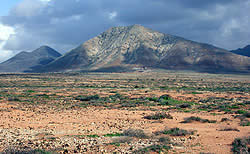 Montaña Tindaya & plains
© Letizia Herrera-Álvarez
greening-up beautifully and should be spectacular with flowers in 10 days - 2 weeks time. The down side
of this was that not once did I get into shorts and tee-shirt as it was cool and cloudy for much of the
time and reptiles, butterflies and dragonflies were disappointing as a result!
Montaña Tindaya & plains
© Letizia Herrera-Álvarez
greening-up beautifully and should be spectacular with flowers in 10 days - 2 weeks time. The down side
of this was that not once did I get into shorts and tee-shirt as it was cool and cloudy for much of the
time and reptiles, butterflies and dragonflies were disappointing as a result!
I ended up with 69 bird species (+ 1 uncertain), which is not bad, but given the strong S - W winds,
I suppose passerine migrants were at a minimum. I was also disappointed in the island, which despite some
gorgeous countryside has decided to go down the 'develop at all costs' route and new groups of houses,
hotels and industrial parks are popping up all over the place. The Malpaís del Huriamen was the last of
these I found, with massive development going on in the middle of what was once a fascinating and largely
intact lava field, but this is just the tip of the iceberg. The Houbaras in particular will presumably get
pushed into ever smaller pockets of remaining habitat.
 Eurasian Collared Dove
Eurasian Collared Dove
Streptopelia decaocto
© John Muddeman
Thursday 24th February
On arrival we saw nothing, and then only a couple of feral pigeons and a Spanish Sparrow on wires en
route. A huge orange solitary potter wasp was stuck inside the foyer of the hotel when we arrived, but I
didn't get too close (!) and a Barn Swallow flashed over as we took baggage to bungalow. Two red
dragonflies also went past all too briefly to try and ID them, but one looked v. like Crocothemis
erythraea.
We later took lunch in a bar in the complex where they told us the force 5+ wind from the SW was not
at all normal. Nor had been the good rain this winter and heavy storm the previous night! Two small and
pale-vented doves on rooftops outside had me intrigued for sometime, since they seemed to fit some African
Collared Dove features, especially when a pair of typical Collared Doves landed beside them! Suddenly
however, the two smaller ones (with paler and relatively shorter primaries in relation to the tail, too)
suddenly started food-begging and were clearly fledglings…
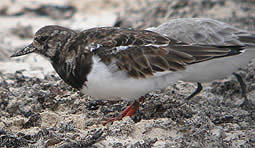 Ruddy Turnstone
Ruddy Turnstone
Arenaria i. interpres
© John Muddeman
We walked back along the sea-front (after photographing a distinctive pyralid moth), where 2 Whimbrel,
a Turnstone, a Common Sandpiper, 3-4 Great Ringed Plover and 6 Sanderling brightened up the rocks, with
Barbary Ground Squirrels (delightful even if introduced!) fed and played in the upper breakwater rocks!
We decided to see if the wind was pushing birds onshore on the W cast so drove to the Faro de Tostón,
near El Cotillo. A Raven, a pair of Egyptian Vultures and various LBJs were seen en route, and lots of
Cory's Shearwaters just offshore from the lighthouse (but this is set back from the shore and with little
cover in the strongish wind). A couple of singing Lesser S-t Larks beside the road en route*. Came back
just after dark to El Cotillo where a Grey Heron flew over. *There is a horrendous and huge new road
running smack through the centre of the dunes for most of the way to the lighthouse and presumably
nothing will now stay in the area close to this. An appalling development, and the outskirts of El
Cotillo are growing apace and in an ugly manner too :-(
 Common Buzzard
Common Buzzard
Buteo buteo insularum
© John Muddeman
Friday 25th February
A sunny start, but both of us with v. heavy colds, so got up late. Breakfast delayed by a tiny cricket in
bedroom, looking like a long slender Myrmecophorus acervorum (but not that sp.), and given rain
until we came out of breakfast, the patio was shiny wet and attractive to a fine Ischnura saharensis!
This was even chivvied indoors and caught for good close-up photos of thorax and pterostigmata. Excellent!
After trying to get info from the tourist office in Caleta de Fuste, where a Monarch was floating around,
we headed S, the aim being to be in the car as much as possible as both not feeling good. We pulled off
onto the road down to Pozo Negro due to three Egyptian Vultures together over hills on left. Single Raven,
Buzzard and Southern Grey Shrike completed the birds except for a fine Berthelot's Pipit which flew and
landed on a roadside bank giving fine views. Both of us commented on how plain and brown it was compared
to those we'd seen on Tenerife a couple of years ago. Maybe just the time of year, i.e. moult / plumage
wear differences?
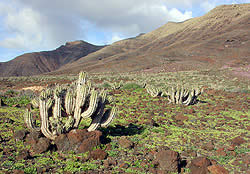 Jandía area & flora
© Letizia Herrera-Álvarez
Jandía area & flora
© Letizia Herrera-Álvarez
Just before reaching the Tuineje municipio, a Little Egret (actually two) on the left stopped me, but a
big pool by 'El Saladillo' on the right held 10 Ruddy Shelduck, with a Hoopoe bringing in food to a nest
among rocks. A couple of km S, another pair of Egyptian Vs were low to the left. Good densities for this
highly threatened subspecies, though the Parque Natural de Pozo Negro is now their stronghold.
We now began the long drive S past several towns including Morro Jable (where a pair of presumed Monk
Parakeets, and another very long and fine-tailed parakeet -presumably Ring-necked- shot past), a group of
five Laughing Doves in flight parallelled the road for some time somewhere in the area and a probable
African Migrant flying round by the La Lajita zoo. Then down along the very long and tortuous track to the
Faro de Jandía. En route on the right was a raised square bank, clearly hiding a reservoir and I made a
note to look at it on the way back. Otherwise just a couple of Buzzards, three fly-past Trumpeter Finches
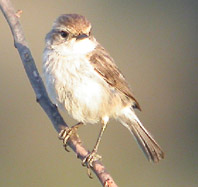 Canary Islands Stonchat female
Canary Islands Stonchat female
Saxicola d. dacotiae
© John Muddeman
and near the end, another Egyptian Vulture the only birds. Ah, and a stop for the first of the masses of
flowers promised by the recent rains and warm conditions, in one of which 2-3 small very yellow butterflies
with black wingtips were zipping energetically about - Greenish Black-tips!
Yellow-legged and a few Lesser Black-backed Gulls were by the lighthouse, plus a pair of copulating
Kestrels just before Puerto de la Cruz.
Return saw the wind finally stop and gorgeous, mild and partially sunny conditions. We stopped by the
reservoir, and this was a great stroke of luck. Climbing up just to take a quick look (and the reservoir
was almost completely dry), I heard a few 'chat' calls and then a few short snatches of stonechat song…
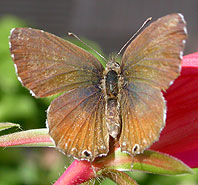 Geranium Bronze
Geranium Bronze
Cacyreus marshalli
© John Muddeman
We reparked and walked up with the gear to see and hear two pairs of Canary Islands Stonechat, sometimes
down to 15 m, but when both females disappeared for some time (!!), the males were much more cagey and
kept their distance. Another chat also called from the shaded S side of the barranco, along with Southern
Grey Shrike and Barbary Partridge. Since the species is apparently much quieter later in the season
(see Brian Small's Surfbirds report), it is immediately identifiable as a stonechat sp., but the call
is weaker and slightly more 'trilled' than for Common, and the song is also very similar but perhaps
slightly less complex and with shorter snatches just a couple of seconds long at most. Still clearly like
Common Stonechat though.
Since it was getting late to try for anything else, but I wanted to try and get to the La Pared area,
we thought of heading off, but displaying Trumpeter Finches low over the craggy ridges above us required
looking at! The rather boring call was not the 'toy trumpet' one so often quoted, but also a distinctive
'dull wheeze', and we finally saw one on the ground feeding on a few seeds. A couple of butterflies also
winged past, including one medium-sized fritillary-like individual, and another probably a Painted Lady.
The drive back was unexciting, but since the Sol Gorriones hotel was closed, we couldn't try and get in
there for the last couple of nights as hoped :-( but probably meant fewer people on the beach there if we
get to visit :-) .
Saturday 26th February
Woke at 6:30 and reached middle part (where crossed by FV2) of Barranco de la Torre by 7:15 when already
completely light. Parked at entrance of track on right c.150m beyond bridge, since it is now chained and
padlocked across. Walked down beside r-h side of building where a nasty dog (chained) and into barranco
almost beside bridge. Singing male Canary Islands Stonechat was first bird and its mate soon appeared…
Walked upstream, noting pair Kestrel, pair Raven and 4 pairs Fuerteventura Stonechat (!), then after c.
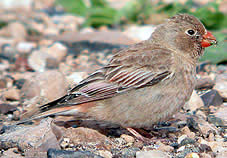 Trumpeter Finch female
Trumpeter Finch female
Bucanetes githagineus amantum
© John Muddeman
400 m a pair Spectacled Warblers nest-building & another singing, but a pair of Little Ringed Plover and
a singing Sardinian Warbler only other birds except for singing Lesser Short-toed and a singing Greater
Short-toed Lark on rocky 'desert' above. Climbed up out of barranco after c. 1 km and cut across birdless
habitat back to car. Crossed back over bridge towards Salinas del Carmen and took first right and drove to
end, almost overlooking barranco from cliff. 4 Turtle Doves (inc. singing and displaying -
they're resident), lots of Sardinian and another singing Canary Islands Stonechat heard. 3 House Martins
edge of Caleta de Fuste on return.
Market in Caleta in morning, with 3+ Turnstones only given lots fishermen and high tide. Also 3
Geranium Bronze butterflies in Caleta de Fustes (I wonder if the reports of Lang's Short-tailed Blue
are correct?).
Long siesta and didn't leave until 5 pm. The Emb. Rosa de Catalina García easily found, but high wind
meant only 5+ Black-winged Stilt, single Spotted Redshank & Greenshank, 10+ Coot and a Little Ringed Plover
seen well. However, we also saw a male Mallard sleeping in the tamarisks, and didn't even realise
how incredibly uncommon they are here!!
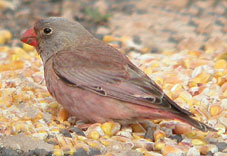 Trumpeter Finch male
Trumpeter Finch male
Bucanetes githagineus amantum
© John Muddeman
Continued towards Vega de Rio Palma, where reservoir visible from road was absolutely at max and very
windy, so didn't go down. An African Blue Tit did land on crash barrier on the roadside just past the
village though and right beside us for several seconds, and this was good since it was too late when we
finally reached Betancuria (pretty place) and none were about. Here there were 100s Spanish Sparrows
(already with chicks), a singing Turtle Dove and a what sounded like an odd-sounding Serin. The latter
was very flighty, and despite it being too dark to see any features, appeared to be a Canary! A later
chance meeting with a local birder confirmed that they are present in the Betancuria area, especially
in the area by the pines.
Came back along new Triquivijate to Costa Calma road (r'bout N of Castillo one) and jokingly said
it was a pity that it so windy that we couldn't listen for Stone-curlew. However, with the window partly
open we actually heard one very close to Triquivijate on our arrival there, and sev. more distant ones
calling, but wind was just too much.
Forecast wet and windy for tomorrow. Maybe opportunity to return for the Mallard!!!
 Ring-necked Duck
Ring-necked Duck
Aythya collaris
© John Muddeman
Sunday 27th February
Headed back S and stopped first when a group of Black-bellied Sandgrouse passed over road then dropped
down to land in field on right beside a good-looking track on N side of road (nr km 22.8 I think, near a
transmission tower for mobiles). Eventually refound these, two more and also another pair much closer
further down the track. Continued S and also saw nine Ruddy Shelduck in place where 10 two days before.
Returned to Emb. Rosa de Catalina García, where a couple of Ruddy Shelduck, a also a spanking adult
male Ring-necked Duck! Also 3 Little Ringed Plovers, a Common Snipe and up to 10 Pallid Swifts, but no
Mallard… :-(
Down to La Lajita where 3 (very flighty) Laughing Doves by track paralleling FV2 opposite zoo and a
couple of Blackcaps in scrub but too windy and not a great place to try and digiscope.
Then to Los Gorriones hotel and took track along 'cliff' to S where watched over flooding salt-marsh
as tide rose. c. 10 Sandwich Terns, 3 imm. Black-headed Gulls, an imm. Spoonbill and lots of Sanderling
(and a poss. Knot), but all waders, gulls and terns disappeared to S (where to?). A female Shoveler on
beach just behind the outer sand bar was very odd! Also then down to Paso del Risco, where S wind evilly
strong, so only went up to look down onto first dune ridge, but also c. 50 L S-t Larks in flock and c. 12
Kentish Plovers also in group on cliff-top.
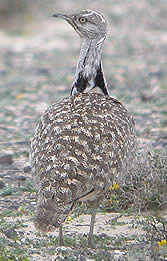 Houbara Bustard
Houbara Bustard
Chlamydotis undulata
© John Muddeman
Finished with a search for Houbaras near La Pared. Drove out using instructions on web and couldn't
find site and fence (we only eventually found the very rusty remains of c. 10 m of barbed wire lying on
ground) mentioned by earlier authors. Picked a good spot of possible habitat though, got out to get gear
from boot and a male Houbara in full display ran between 'bushes' only c. 50 yds away!! We watched this
from car, me still outside, but inevitably, when I moved to get the gear from the boot, the bird 'went to
ground' and despite being visible, refused to move. So got gear inside, moved car sideways to look over
the spot better and the bird started to move, preen and feed in open since we didn't get out! See photo.
It suddenly crouched and ran across open area and over a little ridge, so gave it a couple of minutes and
then followed in car. Ended up with excellent prolonged views, the bird largely ignoring us, it really
having been disturbed by some locals with kids getting out of their 4x4 just out of sight to us! After
c.15 mins and no more display though, we left quietly to leave it in peace. No coursers apart from head
and back of one 'playing dead' at max. range to see it in scope and this a bit disappointing.
Ate dinner in restaurant in La Pared bar (v. disappointing after excellent first course of sopa de
marisco).
Monday 28th February
Went N to Corralejo to look for a hotel for last 2 nights. Easy! Found one (Aparthotel Hesperia Bristol
Playa) almost immediately in NW of town with views to Lanzarote and over a small bay. Little Egrets,
Turnstones, and Whimbrel plus a Common Sandpiper on rocks in front a good omen.
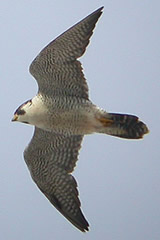 Barbary Falcon
Barbary Falcon
Falco pelegrinoides
© John Muddeman
Went down W coast and after excellent lunch in Tindaya (Bar El Encuentro), went down road to Punta Paso
Chico (following notes on internet saying that Cream-coloured Coursers may be seen there). Road is average
to good, and very quiet, passing good habitat and ending at cliff where no serious building to date.
Proved to be good, with two Houbaras seen (albeit distantly / briefly en route) then at distance, several
pale birds running around… Coursers!!! About 5 and fun to watch them speeding across the rocky fields
(I had no idea what they'd be like before going, so fun to see them living up to their name). Continued
down to coast where wanted to watch seabirds, but no real passage despite lots of Cory's in raft on sea,
and also soon distracted by a falcon overhead. Had to be a Barbary, so got the scope out, only to find a
big female Peregrine-like bird hanging in the updraft from the onshore wind. in fact, as it stayed up high
except during one rather distant and fast dive, and did not appear to show rufous on the nape and had a
peregrine-like pale rump, I assumed it was this species. Fortunately it spent c. 20 minutes planing
gently back and forth, long enough to get a series of photos, before moving off to intercept another,
smaller falcon coming N up the coast. This time a male, given the smaller size, and apparently 1st-winter
given lack of moult and rather brownish upps. In fact, it wasn't until I was back at home, and posted
the beast onto a Spanish digiscoping forum that its true identity as an eastern Canary Islands' Barbary
Falcon was finally confirmed.! While this may sound a daft mistake, the birds here are very much
half-way-houses between the two species, and can even lack the rufous nape patch altogether!
Came back to see one of the Houbaras in exactly the same place where we'd seen it hours before, and
it was now standing and preening in good light. A group of 5 Coursers on the left this time and further
ahead, another group of three Coursers, this time closer, but in such poor light that photography
impossible! A fun way to end though!
 Scarlet Darter female
Scarlet Darter female
Crocothemis erythraea
© John Muddeman
Tuesday 1st February
In summary a day of Trumpeter Finches and Lesser S-t Larks…
Pre-breakfast in Barranco de la Torre (nothing in Salinas del Carmen), where T Finches started to arrive
in one of the old arable fields by buildings and palm trees. Finally, 60+ in total all buzzing, beeping
and seed-cracking, but not easy to approach! Spanish Sparrows too and Hoopoe singing in distance.
Pools near moth of barranco promising but almost insect and bird-free, but tamarisk bushes with a few
Sardinian and Spectacled Warblers, while a singing warbler was a fine male Subalpine, a Redwing called and
flew past and a Common Chiffchaff came out when I was mobbed by Spanish Sparrows! Photographed a Common
Buzzard and noted flock of 17 Raven going over, which were then hassled by a resident bird. A female
Scarlet Darter and male Ischnura saharensis pulled out by the now warm sun on the edge of the pools.
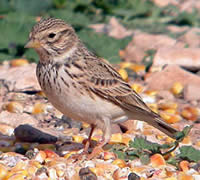 Lesser Short-toed Lark
Lesser Short-toed Lark
Calandrella rufescens polatzeki
© John Muddeman
Transferred to Corralejo where checked in, then left late and went again for lunch to Bar El Encuentro
in Tindaya. Later to Ecomuseo in Tefía, where after going round about half the houses, found an area
covered with L S-t Larks, T Finches and a few Spanish Sparrows feeding on maize spread for doves and
perhaps goats. Returned for telescope to digiscope and also found another very flighty Laughing Dove
feeding there, but no chance to photograph it! A Turtle Dove was easy in comparison though!
Left rather late and went straight towards the famous Emb. de Los Molinos. Just behind the goat farm at
Las Parcelas, masses of L S-t Larks and Trumpeter Finches at point black range, again feeding on maize
spread out for goats and other animals… The reservoir is frankly ugly, ugly, but 5+ Ruddy Shelduck, a
Grey Heron, 3 Little Ringed Plover, and at far end, 4 male and 2 female Common Teal and a Greenshank at
least took our minds off the cold wind. Light was failing by the time we came out but a very brief
Stone-curlew in road on the way back was the only one we saw.
Wednesday 2nd February
Went to shop after breakfast and when distracted by traffic, missed r'bout, which meant I saw a roadside
Cattle Egret ahead!
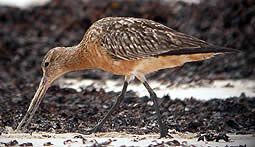 Bar-tailed Godwit summer plumage
Bar-tailed Godwit summer plumage
Limosa l. lapponica
© John Muddeman
Later start after going into Corralejo and cloudy again, so headed towards El Cotillo dunes. Bumped
into Juanjo, a Tenerife birder, working presently in Fuerteventura, and censussing the waders in the bay
just E of the Faro del Tostón. Saw a passing Gannet with Cory's S's, also 2-3 Grey Plovers, a Common
Redshank and 6+ Bar-tailed Godwit, inc. one in almost full summer plumage, plus Turnstones, Kentish Plovers
and Sanderlings. This bay easily the best for waders given the dead seaweed thrown up on the beaches.
Finished by going for a walk across the mobile dunes SE of Corralejo. Two Whimbrels and lots of Rabbits
an interesting mix!
Thursday 3rd February
Windy start so didn't bother with a pre-breakfast drive. Packed and headed for airport via Corralejo
dunes again, where for the first time the sun and flatter sea allowed us a few minutes rock-pooling.
Lovely, and sea warmer than expected but no time to swim! Two Barn Swallows and a Sandwich Tern hugging
coast going N in SW wind.
Flight delayed c. 30 minutes, probably knock-on from bad weather in mainland Spain and C and W Canaries!
A) Birds
- Ruddy Shelduck [Tarro canelo] Tadorna ferruginea 10 beside FV2 road in pool opposite 'El Saladillo' (S of Pozo Negro turning) on 25th, 1 Barranco de la Torre bridge + and group (as on 25th) on 26th, 9 beside FV2 and 2 Emb. Rosa de Catalina García on 27th, 5 Emb. de los Molinos on 1st.
- Mallard [ánade real] Anas platyrhynchos A male in tamarisks Emb. Rosa de Catalina García on 27th was a good bird!
- Common Teal [Cerceta común] Anas crecca 4 mm + 2 ff Emb. de los Molinos on 1st.
- Northern Shoveler [Pato cuchara] Anas clypeata A female behind barrier sand on Playa de Sotavento on 27th.
- Ring-necked Duck [Porrón acollarado] Aythya collaris A superb male Emb. Rosa de Catalina García on 27th.
- Barbary Partridge [Perdiz moruna] Alectoris barbara koenigi Heard Casas de Jorós on 25th, a pair Barranco de la Torre on 1st, pair nr Lajares on 2nd and pair just S of Montaña Rosa on 3rd.
- Cory's Shearwater [Pardela cenicienta] Calonectris diomedea borealis Common offshore but not easy to see close; 50+ Faro del Tostón on 24th and 30+ there on 2nd, and 2-300 Punta de Paso Chico on 28th.
- Northern Gannet [Alcatraz atlántico] Morus bassanus One imm N past Faro del Tostón on 2nd.
- Cattle Egret [Garcilla bueyera] Bubulcus i. ibis One on SW edge of Corralejo on 1st.
- Little Egret [Garceta común] Egretta g. garzetta Quite common, especially along coasts; seen daily in small number Caleta de Fustes, Barranco de la Torre and especially Corralejo, and also inland inc. Emb. Rosa de Catalina García (inc. 10+ on 27th) and Emb. de Los Molinos.
- Grey Heron [Garza real] Ardea c. cinerea Singles El Cotillo on 24th and 2nd, 2 Sol Gorriones, Jandía on 27th and 1 Emb. de Los Molinos on 2nd.
- Eurasian Spoonbill [Espátula común] Platalea leucorodia 1 imm. Playa de Sotavento on 27th.
- Egyptian Vulture [Alimoche] Neophron percnopterus *majorensis 2 ad. Montañeta Quinta on 24th, 3 over turning to Pozo Negro, 2 ad beside FV2 nr Teguital and 1 ad El Manajito plain, Puerto de la Cruz on 25th, and 1 ad. Emb. Rosa de Catalina García on 27th.
- Common Buzzard [Busardo común] Buteo buteo insularum Quite widespread in small number; 2 Lajares-El Roque on 24th, 6+ on 25th and 26th, 3 on 27th and 1 Barranco de la Torre on 1st.
- Common Kestrel [Cernicalo común] Falco tinnunculus dacotiae Quite widespread in small -moderate number; 2-5+ daily, with pairs very sedentary; copulating pair Puerto de la Cruz on 25th.
- Barbary Falcon [Halcón tagarote] Falco (peregrinus) pelegrinoides -ish! A superb pale and moulting female hanging in the wind over Punta Paso Chico for a long time on 28th, then headed off to intercept a (probably younger) male passing from the S!
- Moorhen [Gallineta común] Gallinula c. chloropus Just one briefly at Emb. Rosa de Catalina García on 27th.
- Coot [Focha común] Fulica a. atra 10+ Emb. Rosa de Catalina García on 26th and 27th, 12+ Emb. de Los Molinos on 1st.
- Houbara Bustard [Avutarda hubara] Chlamydotis undulata fuertaventurae A stunning male Istmo La Pared on 27th and 2 Tindaya area on 28th.
- Black-winged Stilt [Cigüeñuela común] Himantopus h. himantopus 4-5 Emb. Rosa de Catalina García on 26th and 4 there on 27th.
- Stone-curlew [Alcaraván común] Burhinus oedicnemus insularum Sev. heard outskirts Triquivijate on 26th, then one very briefly in road at dusk nr Tefía on 1st.
- Cream-coloured Courser [Corredor sahariano] Cursorius c. cursor (inc. bannermanni) One very distant view Istmo La Pared on 27th and 5, then 5 + 3 Tindaya area on 28th.
- Little Ringed Plover [Chorlitejo chico] Charadrius dubius curonicus 2 Barranco de la Torre on 26th, 1 Emb. Rosa de Catalina García on 26th and 3 there on 27th, 1 La Lajita on 27th and 1 Barranco de la Torre and 3 Emb. Los Molinos on 1st.
- Greater Ringed Plover [Chorlitejo grande] Charadrius hiaticula ?sspp. 3-4 Caleta de Fustes on 24th, 10+ Faro Jandía on 25th, 1 Corralejo on 28th and 7+ Faro del Tostón on 2nd.
- Kentish Plover [Chorlitejo patinegro] Charadrius a. alexandrinus 12+ Playa de Sotavento on 27th and 5+ Faro del Tostón on 2nd.
- Grey Plover [Chorlito gris] Pluvialis squatarola 2+ Faro del Tostón on 2nd.
- Sanderling [Correlimos tridáctilo] Calidris alba 6 Caleta de Fustes on 24th, 70+ Playa de Sotavento on 27th and 12+ Faro del Tostón on 2nd.
- Red Knot [Correlimos gordo] Calidris canutus 1 possible bird on the Playa de Sotavento on 27th but disappeared before I could get scope on it.
- Common Snipe [Agachadiza común] Gallinago gallinago ?gallinago One Emb. Rosa de Catalina García on 27th.
- Bar-tailed Godwit [Aguja colipinta] Limosa l. lapponica 6+ Faro del Tostón on 2nd.
- Whimbrel [Zarapito trinador] Numenius p. phaeopus 2 Caleta de Fustes on 24th, 1 Corralejo on 28th, heard Caleta de Fustes on 1st, 8+ various sites on 2nd.
- Spotted Redshank [Archibebe oscuro] Tringa erythropus One Emb. Rosa de Catalina García on 26th and 27th.
- Common Redshank [Archibebe común] Tringa totanus ?totanus 1 Faro del Tostón on 2nd.
- Common Greenshank [Archibebe claro] Tringa nebularia One Emb. Rosa de Catalina García on 26th and 2 there on 27th, 1 Emb. Los Molinos and1 in barranco below on 1st.
- Common Sandpiper [Andarríos chico] Actitis hypoleucos 1 Caleta de Fustes on 24th, 1 Corralejo on 28th, 1 Barranco de la Torre and 2+ Emb. Los Molinos on 1st.
- Ruddy Turnstone [Vuelvepiedras común] Arenaria i. interpres 1 Caleta de Fustes on 24th and 3+ there on 26th, 3 Corralejo on 28th, 15+ Faro del Tostón on 2nd.
- Black-headed Gull [Gaviota reidora] Larus ridibundus 3 imm. Playa de Sotavento on 27th.
- Lesser Black-backed Gull [Gaviota sombría] Larus fuscus graellsii & intermedius 3 Faro de Jandía on 25th, 10+ Playa de Sotavento on 27th, lots La Oliva area on 28th and sev. on 1st and 2nd.
- Yellow-legged Gull [Gaviota patiamarilla] Larus michahellis atlantis Common and seen widely daily.
- Sandwich Tern [Charrán patinegro] Sterna s. sandvicensis 9+ Playa de Sotavento on 27th.
- Black-bellied Sandgrouse [Ganga ortega] Pterocles o. orientalis 11 + 2 + 2 from track km 22.8 of FV2.
- Rock Dove [Paloma bravía] Columba l. livia [ inc. canariensis] Seen daily and widely, and while many were feral pigeons, wild-type birds were present at many sites, especially along the coast.
- Eurasian Collared Dove [Tórtola turca] Streptopelia d. decaocto Abundant and widespread.
- European Turtle Dove [Tórtola común] Streptopelia t. turtur 4 Barranco de la Torre and 1 Betancuria on 26th and 1 Tefía on 1st.
- Laughing Dove [Tórtola senegalesa] Streptopelia senegalensis ?phoenicophila 5 Morro Jable area on 5th, 3 La Lajita on 27th and 1 Tefía on 1st. Local feeling is that these are birds from natural expansion from Africa, and not establishing from escapes.
- Rose-ringed Parakeet [Cotorra de Kramer] Psittacula krameri ?ssp. [Int.] 1, apparently this species, very briefly over FV2 in SE on 25th.
- Monk Parakeet [Cotorra Argentina] Myiopsitta monachus ?ssp. [Int.] Two close to FV2 Morro Jable on 25th.
- Pallid Swift [Vencejo pálido] Apus pallidus brehmorum 10+ Emb. Rosa de Catalina García and 4 Sol Gorriones on 27th, 3 + 1 Punta de Paso Chico on 28th, 3 Emb. Los Molinos on 1st and 10+ just W of El Roque on 2nd.
- Eurasian Hoopoe [Abubilla] Upupa e. epops Widespread but rather scarce; 1 El Cotillo on 24th, 1 El Saldillo on 25th, 2 Barranco de la Torre on 26th, 1 Sol Gorriones on 27th, 2 Punta Paso Chico on 28th and 1h Barranco de la Torre on 1st.
- Greater Short-toed Lark [Terrera común] Calandrella b. brachydactyla One singing to N of Barranco de la Torre on 26th.
- Lesser Short-toed Lark [Terrera marismeña] Calandrella rufescens polatzeki Abundant widespread resident; seen daily, but especially Istmo a Pared on 27th and Tefía and Las Parcelas on 1st.
- Barn Swallow [Golondrina común] Hirundo r. rustica 1 Caleta de Fustes on 24th and 2 Corralejo dunes on 3rd.
- Common House Martin [Avión común] Delichon u. urbicum Just three over FV2 Caleta de Fustes on 1st.
- Tawny Pipit [Bisbita campestre] Anthus campestris One watched well from the track to 'Pueblo del Mar', and quite close to FV605 road (to La Pared) on 27th.
- Berthelot's Pipit [Bisbita caminero] Anthus berthelotii Widespread and seen daily, but not in large number.
- Canary Islands Stonechat [Tarabilla canaria] Saxicola d. dacotiae 2 pairs seen + 1 heard Casas de Jorós, Jandía on 25th and 4+ pairs and 1 heard Barranco de la Torre (all in FV2 bridge area) on 1st.
- Redwing [Zorzal alirrojo] Turdus iliacus ?ssp. 1 Barranco de la Torre on 1st.
- Blackcap [Curruca capirotada] Sylvia atricapilla ?heineken 3+ La Lajita on 27th.
- Spectacled Warbler [Curruca tomillera] Sylvia conspicillata orbitalis Heard and seen at a few sites in small number; nest-building Barranco de la Torre on 25th.
- Subalpine Warbler [Curruca carrasqueña] Sylvia cantillans ?cantillans A fine singing male in the Barranco de la Torre on 1st.
- Sardinian Warbler [Curruca cabecinegra] Sylvia melanocephala leucogastra Only seen Barranco de la Torre on 26th and 1st.
- Common Chiffchaff [Mosquitero común] Phylloscopus collybita ?collybita Just 1, later singing, Barranco de la Torre on 1st.
- African Blue Tit [Herrerillo sp. - no tiene nombre oficial todavía] Parus teneriffae degener 1 on crash barrier near Vega de Rio Palma on 26th.
- Southern Grey Shrike [Alcaudón real meridional] Lanius meridionalis koenigi Widespread and often most obvious passerine; seen daily in small - moderate number.
- Common Raven [Cuervo] Corvus corax canariensis Widespread and quite common resident; seen daily. Max. 18 Barranco de la Torre on 1st.
- Spanish Sparrow [Gorrión moruno] Passer h. hispaniolensis Common and widespread resident; seen daily.
- Atlantic Canary [Canario] Serinus canaria 1 Betancuria on 26th.
- Common Linnet [Pardillo común] Carduelis cannabina harterti Just 1 heard Sol Gorriones on 27th, 2 heard Punta Paso Chico on 28th and heard on 1st.
- Trumpeter Finch [Camachuelo trompetero] Bucanetes githagineus amantum Widespread resident; lots of display flights at various sites, but often very thin on ground. Seen on 6 days, max. 60+ Barranco de la Torre, 20+ Tefía and 50+ Las Parcelas on 1st.
- Corn Bunting [Triguero] Miliaria c. calandra Remarkably scarce; 1 El Cotillo on 24th and 1 singing Lajares on 2nd.
B) Mammals
- Algerian Hedgehog [Erizo moruno] Atelerix algirus [Int.] Plenty dead on roads.
- Bat sp. (presumably either Savi's Pipistrelle Hypsugo savii and / or Kuhl's Pipistrelle Pipistrellus kuhlii) Singles over road en route on 25th and 27th.
- Barbary Ground Squirrel [Ardilla moruna] Atlantoxerus getulus [Int.] 7+ Caleta de Fustes on 24th, 3+ Casas de Jorós on 25th, also noted on 26th, 27th and 1 Tefía on 1st.
- Brown Rat [Rata parda] Rattus norvegicus [Int.] 1 dead on road Tindaya on 28th.
- Rabbit [Conejo] Oryctolagus cuniculus [Int.] Seen on 4 days, max. 10s Corralejo dunes on 2nd.
C) Amphibians & Reptiles
- Miserable!: just one Gecko sp. [Perenquén majorero] Tarentola angustimentalis or very small Haria Lizard [Lagarto atlántico] Gallotia atlantica mahoratae seen disappearing into a thorny shrub at El Cotillo on 2nd. Presumably everything was under cover given the cool conditions?
D) Butterflies
- Bath White [Blanquiverdosa] Pontia daplidice and / or Green-striped White [Blanca verdirrayada] Euchloe belemia singles seen from car Corralejo on 28th and La Oliva on 1st.
- Greenish Black Tip [Puntaparda verdosa] Elphinstonia charlonia 2-3 Jandía on 25th, 2-3 Corralejo (market area!) 28th and 1 Tefía on 1st.
- African Migrant [Migradora africana] Catopsilia florella Just 1 probable from car La Lajita on 25th.
- Clouded Yellow [Amarilla] Colias crocea 1 Jandía on 25th.
- Geranium Bronze Cacyreus marshalli 3 Caleta de Fustes on 26th.
- Monarch [Monarca] Danaus plexippus 1 Caleta de Fustes on 25th.
- Painted Lady [Cardera] Vanessa cardui 1 probable Casas de Jorós on 25th and 1 Barranco de la Torre on 1st.
E) Dragonflies
- (blue-tailed damselfly sp.) Ischnura saharensis 1 Caleta de Fustes on 25th and 1 male Barranco de la Torre on 1st.
- Scarlet Darter Crocothemis erythraea 1 male prob. this sp. Caleta de Fustes on 24th and 1 female Barranco de la Torre on 1st.
John Muddeman
Natural history tours of Fuerteventura:
A Voyage of Discovery in the Canary Islands
Related information:
Natural history of the Canary Islands
See John's natural history tours this year
Wildlife holidays and tours in Spain and Portugal
|